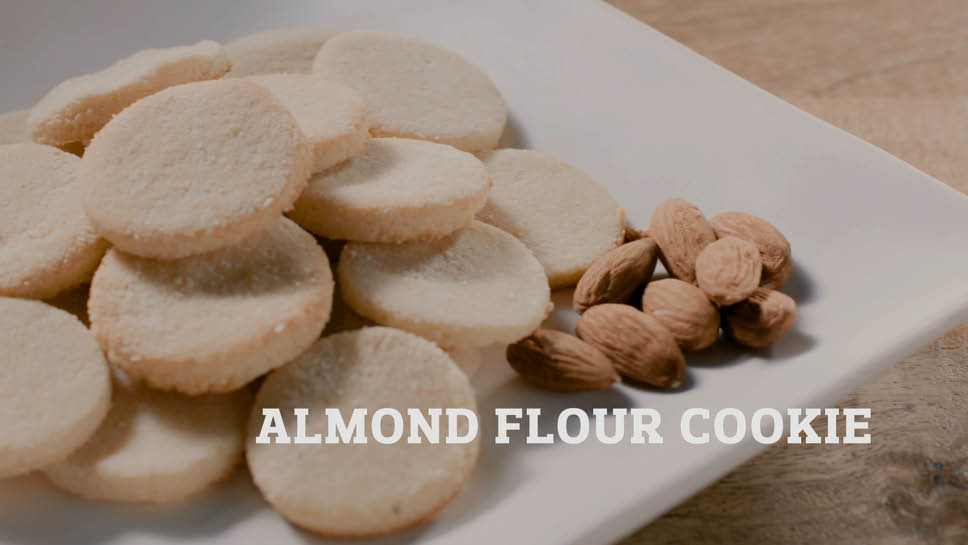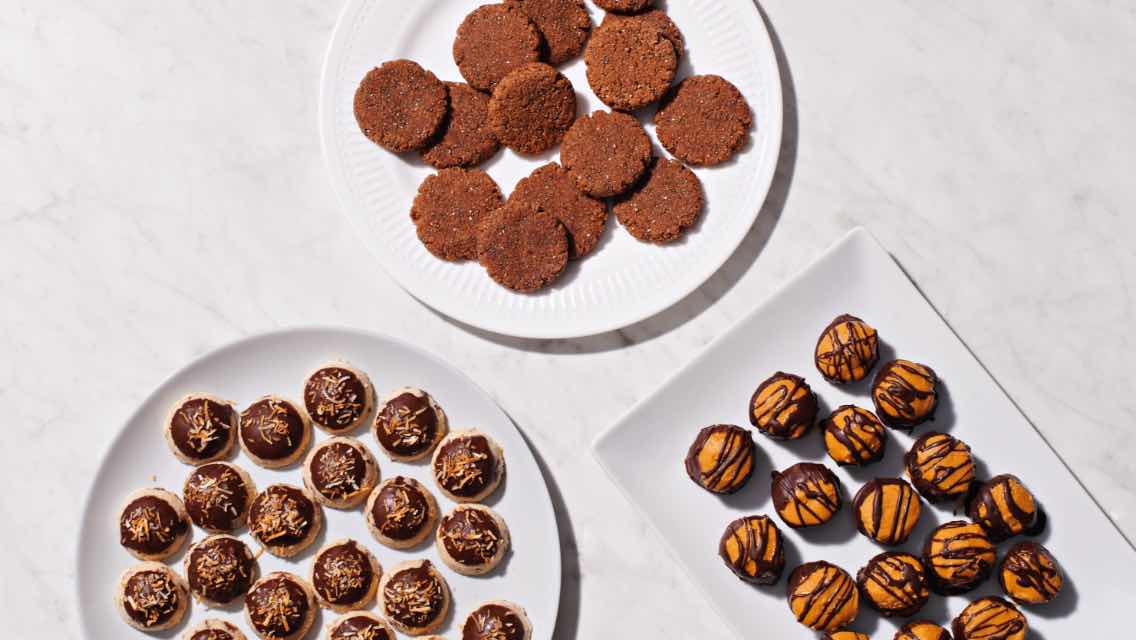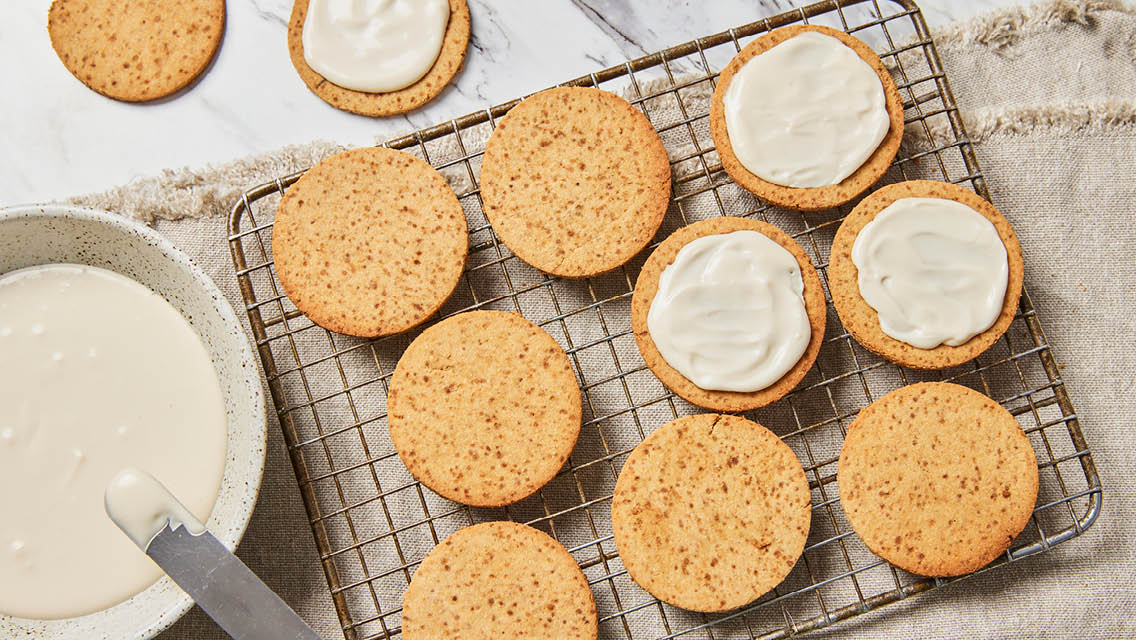Explore these healthier substitutes for these common ingredients:
Flour ⋅ Sugar ⋅ Vegetable Oils ⋅ Eggs ⋅ Milk or Heavy Cream ⋅ Margarine or Butter ⋅ Chocolate Chips ⋅ Cookie Recipes
Can you smell that? It’s the aroma of your favorite holiday baked goods — cookies, pies, cakes, and breads — filling the air as you try to maintain the healthy eating habits you’ve worked so hard to establish throughout the year.
If you’re like me, you may struggle with wanting to enjoy your favorite treats without overindulging or completely derailing your day. (Or, let’s face it, your entire week.) The good news is there’s a plethora of alternative ingredients that allow you to give many traditional holiday baking recipes a healthy update, so you can partake in good conscious.
It can be difficult to know where or how to swap, so I pulled together this guide of some of the top ingredient substitutes to add to your pantry, so you’re ready when holiday baking commences.
Flour
Most baking recipes call for all-purpose flour or one of the many versions of this wheat-based staple. All-purpose flour is typically bleached and highly processed, making it ideal for baking, but less-than-healthy for you. The gluten in flour can also be problematic for some people, as gluten is a known cause of dietary inflammation that can lead to gastrointestinal problems, as well as other metabolic issues. There are now a multitude of other flour options on the shelves, including the gluten-free ones on this list.
Swaps
- Nut flours. These include almond, pecan, hazelnut, walnut, cashew, and macadamia nut flours. Store these in your refrigerator or freezer to extend their shelf-life.
- Grain flours. Oat, quinoa, and brown rice are all whole-grain, gluten-free options.
- Bean and legume flours. These could be chickpea, black bean, or white bean flours.
- Coconut flour. This has a bit of a nutty taste, but is a common alternative that’s preferred by many due to its wide availability and ease of use as a substitute.
Note: Not all flour alternatives are a one-to-one substitute for all-purpose flour, so be sure to look at the package instructions or do a quick Google search on the ingredient to find the right swap ratio.
Sugar
We all know that sugar is one of the toughest things to limit throughout the holidays, particularly processed sugars, as they’re found in many packaged foods and other treats. So if you can choose healthier options and cut your intake back in even a few dishes, that’s a major win. Try using these more natural sweeteners instead.
Swaps
- Raw honey or agave nectar. These natural options have long been recommended as sugar alternatives in baking.
- Maple syrup. Look for pure maple syrup, avoiding synthetic versions made with corn syrup.
- Molasses. This is less sweet than sugar, but works nicely in a lot of recipes.
- Coconut sugar. Use this as an easy one-to-one substitute for either brown or white sugar.
- Monk fruit. This natural alternative is significantly sweeter than sugar, so use half the amount the recipe advises.
- Stevia. You can typically swap this in equal parts for sugar, but some people don’t care for the slightly bitter finish it can have on the palate.
Note: Watch out for sucralose baking blends. (Sucralose may be identified on an ingredient list or may be listed by the common product name “Splenda.”) They have been on the market for years and still appeal to many bakers aiming for a “healthier” treat. I suggest avoiding them, as sucralose has been found to negatively influence thyroid hormones and gut health.
Also, if you’re using a liquid alternative such as honey, agave nectar, maple syrup, or molasses, you’ll likely want to use a smaller amount than what’s called for. You may also need to reduce the total liquid ingredients in the recipe to prevent it from becoming too soggy.
Vegetable Oils
Many recipes include vegetable oil, as it creates a binding effect that gives breads and cakes a soft, crumb-like texture. Most vegetable oils, however, are highly processed and contain hydrogenated oils that are inflammatory, among a myriad of other negative health effects. Instead of vegetable, soybean, or canola oil, try one of these alternatives, most of which can be substituted in a one-to-one ratio.
Swaps
- Grapeseed oil. The high smoke point and mild flavor of this oil makes it ideal for baking.
- Coconut oil. Unless you want a coconut flavor, choose refined coconut oil for a more neutral taste.
- Olive oil. Use light or extra-light olive oil as it has a higher smoke point than extra-virgin olive oil and won’t affect the taste as much.
- Unsweetened applesauce. Yes, this really works!
- Melted grass-fed butter. See the “margarine or butter” section below for more details on this great alternative.
- Nut butter. Use natural nut butters that don’t contain any added sugar. The oils can separate from the solids inside the container, so mix it well before using to get the full moisture and flavor.
Eggs
While eggs are not bad for you, sensitivities to eggs have become fairly common, so using a substitute is a great way for those individuals — or vegans — to still enjoy a sweet treat from time to time.
Swaps
- Flaxseed or chia seed paste. For the equivalent of one egg, mix 1 tablespoon of flaxseed or chia seed with 3 tablespoons of water. (Or use this flaxseed “egg” recipe.)
- Unsweetened applesauce. Use 1/4 cup in place of one whole egg.
- Mashed banana, pumpkin, or avocado. 1/4 cup works in place of one egg here as well. If you use banana, it can give your final product a slight banana flavor.
- Yogurt or buttermilk. Again, 1/4 cup will replace one egg here. Ideally, select organic, whole-fat options without any added sugars.
- Egg alternative. These store-bought options are often made from a starch, such as potato or tapioca, and mixed with leavening agents.
Milk or Heavy Cream
Unless you’re sensitive to dairy or looking to remove it from your diet, you can feel good about using organic milk or heavy cream, ideally choosing whole fat. The higher the milk fat, the less processed the product — and the more satiating it is. If you’d like another option, try one of these suggestions.
Swaps
- Dairy alternatives. These include almond, cashew, coconut, or oat milk. Most of these can be substituted one-for-one with cow’s milk, however, know that they may not provide the same creaminess as a full-fat dairy product.
- Water. Many people will skip the dairy altogether and simply add water in its place. Again, you’ll likely sacrifice some texture with your finished product if you go this route.
Note: While soy milk is a dairy alternative used by many, it’s not an ideal option. Soy can have many benefits, however, processed soy may negatively influence hormones over time, so it’s best to limit processed soy sources, like soy milk.
Margarine or Butter
Margarine is never a good choice as it can contain trans fats, which are pro-inflammatory, but the old adage that butter is “clogging your arteries” couldn’t be further from the truth. It’s simply about being a little more selective about the type of butter you choose.
Swaps
- Grass-fed butter. This is a step up from conventional stick butters, as it contains more conjugated linoleic acid, which helps to fight inflammation and may help you burn more fat. It also contains butyrate, which is known to help improve gut health.
- Ghee. Favored in many cultures for cooking, this butter alternative has had its milk proteins removed, making it easier for some people with gastrointestinal issues to digest. Due to its higher fat concentration, you may want to use 75 percent of the amount of butter called for in your recipe. Ghee can also produce a crispier final product, so it may not be ideal for all recipes.
Note: Don’t be fooled by plant-based butter alternatives that claim to be “heart healthy.” Many of these options are laden with inflammation-promoting omega-6-rich oils that aren’t the best choices if you’re health conscious.
Chocolate Chips
Who doesn’t love a soft, warm chocolate chip cookie? The good news is there are a few simple ways to increase the health factor of the chocolate in this classic treat — and other recipes that call for it.
Swaps
- Dark chocolate chips. Aim for 70 percent cocoa or higher. (Look here for how to find the healthiest dark chocolate.)
- Cacao nibs. These are unprocessed and make for a great, healthy alternative to chocolate chips. However, they may not appeal to all, as they taste a bit earthy, have a significant crunch, and won’t melt like traditional chips.
No-Swap-Needed Holiday Cookies
Not quite ready to experiment with your own recipe? Try these two holiday cookies that already have all of the healthy swaps made for you.
Gingerbread Cookies

Makes 12 large or 24 small cookies, depending on size of cookie cutter
Prep time: 10 minutes
Cook time: 12 minutes
Ingredients
- 1 cup almond flour
- 1 1/2 cups raw oatmeal, ground into flour
- 1 1/2 tbs. pumpkin pie spice
- 1 tsp. baking powder
- Pinch of sea salt
- 1/2 cup blackstrap molasses
- 1/4 cup coconut oil, melted
- 1 tsp. vanilla
- Oat flour for rolling the dough
Directions
- Preheat the oven to 350 degrees F.
- In a medium-size bowl, add the almond flour, ground oatmeal, pumpkin pie spice, baking powder, and sea salt. Whisk to combine.
- In a small, microwaveable bowl, combine the molasses, coconut oil, and vanilla. Heat until melted, about 30 seconds.
- Add the liquid ingredients to the dry ingredients and stir to combine.
- On a well-floured surface (using the extra oat flour), lay out the dough and roll with a rolling pin until it’s about 1/4-inch thick.
- Use a cookie cutter to cut desired shapes, and lay flat on a greased, 9×13 baking sheet.
- Bake for 11 to 12 minutes, or until browned.
Source: Life Time Training Team
Almond Flour Cookies

Makes 12 to 15 cookies
Prep time: 40 minutes including dough chilling time
Cook time: 15 minutes
Ingredients
- 2 cups almond flour
- 1 large egg (or equivalent substitute if you’re avoiding eggs)
- 2 tbs. coconut oil
- 2 tbs. pure maple syrup
Directions
- Combine all of the ingredients to form a dough, then chill it in the refrigerator for about 30 minutes.
- Preheat the oven to 350 degrees F.
- Roll the dough out until it’s about 1/4-inch thick. Cut into desired shapes.
- Line a baking sheet with parchment paper, place cut cookies on it, and bake for 12 to 15 minutes.
- If desired, top the cookies with some nut butter, or a mix of coconut oil and honey for a healthy glaze.
Source: The Life Time Foundation





This Post Has 0 Comments